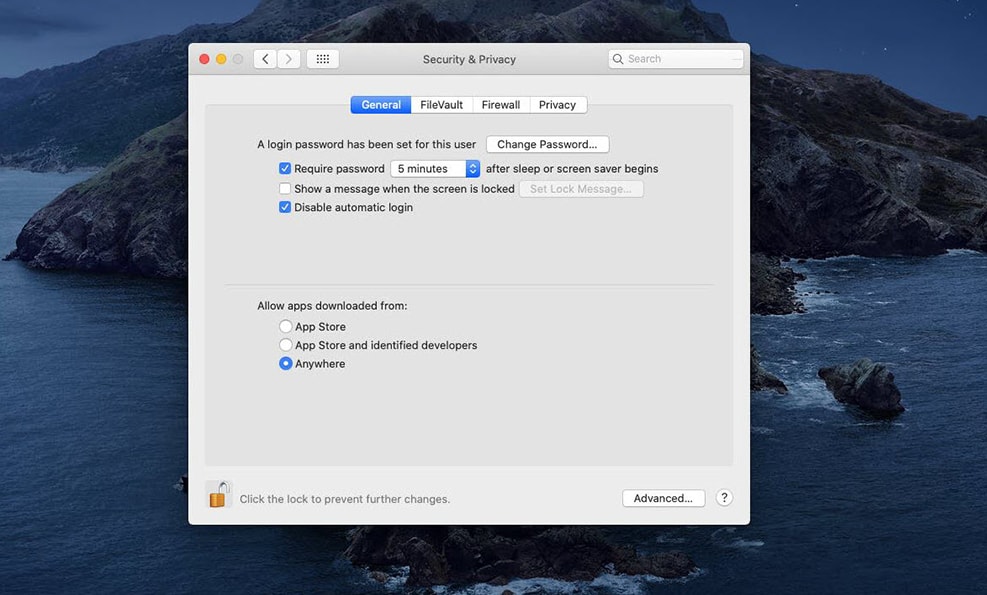
Moving from your PC to your new Mac? Consider it done.
Running software that hasn’t been signed and notarized may expose your computer and personal information to malware that can harm your Mac or compromise your privacy. If you’re certain that an app you want to install is from a trustworthy source and hasn’t been tampered with, you can temporarily override your Mac security settings to open it. Just the Mac App Store. The safest option to choose here would be the 'Mac App Store,' since Apple reviews all apps that are accepted in their store and can remove them quickly if necessary. You will know that your Mac will be as free as possible from malware if you use this option only. Mac App Store & Trusted Developers. When it comes to Mac, there are two possible solutions for a third-party firewall based on your budget. Those in need of free support should look into Avast for Mac for their troubles. It’s been a large name in the antivirus market for some time now and offers great software packages that include firewalls.
With macOS, you can move all the information from your old PC to your new Mac. Built-in Windows-to-Mac migration in macOS automatically transfers your documents, music, contacts, calendars, and email accounts (Outlook and Windows Live Mail), and puts them in the appropriate folders and applications on your new Mac. Just like that.
If you buy your Mac at an Apple Store, Personal Setup can help you get off to a great start.
Work with anyone.
Every Mac comes with Pages, Numbers, and Keynote — powerful productivity apps from Apple that help you create stunning documents, spreadsheets, and presentations. You can collaborate with one person or many people to create and edit Pages, Keynote, and Numbers files. And everyone can work on the same document at the same time — from across town or across the globe. You can also open, edit, and save Microsoft Word, Excel, and PowerPoint files with these apps, so you can easily work with others, regardless of whether they’re on a Mac or PC.
Use Microsoft Office for Mac. Connect to Microsoft Exchange Server.
Fun fact: There’s a version of Microsoft Office written just for Mac. So you can use Word, Excel, and PowerPoint on a Mac just like on a PC.
macOS also provides built-in support for the latest version of Microsoft Exchange Server. So you can use all the apps you love on your Mac, and have access to your mail, contacts, and calendar from the office, all at the same time.
Access your files from anywhere with iCloud.

Your Mac comes with iCloud Drive, which lets you safely store all your presentations, spreadsheets, PDFs, images, and any other kinds of files in iCloud. Then you can access them from any device, including your iPhone, iPad, iPod touch, Mac, or PC.1
Allow Third Party Downloads Mac
Industry standard‑bearer.
Thanks to its support for industry standards, macOS works with virtually all email providers and websites. It also lets you view the most common file types, including Office documents, PDFs, images, text files, MP3s, videos, ZIP files, and more.
So if you’re moving files from a PC or if your friends and colleagues send you files, you can rest assured they’ll work beautifully on your Mac.
Relax. Your camera, printer, and mouse work, too.
Almost any device that connects to a computer via USB, audio cable, or Bluetooth will work with a Mac. That includes digital cameras, external hard drives, printers, keyboards, speakers, and even your right-click mouse. And with technologies like AirPrint and the array of class drivers included with macOS, you can start using these devices as soon as you plug them in — no need to manually download additional software.
A Mac can even run Windows.
Have a Windows application you need to use once in a while? No problem. Every new Mac lets you install and run Windows at native speeds, using a built-in utility called Boot Camp.
Setup is simple and safe for your Mac files. After you’ve completed the installation, you can boot up your Mac using either macOS or Windows. (That’s why it’s called Boot Camp.) Or if you want to run Windows and Mac applications at the same time — without rebooting — you can install Windows using VMware or Parallels software.2
Connect to PCs over a network.
The Finder not only lets you browse files on your Mac, it also makes it easy to find files on other computers — both Mac and PC — on your home network. Computers that allow file sharing automatically show up in the Shared section of the Finder sidebar, allowing you to browse files and folders you have permission to view.
Works on macOS
- Microsoft Office for Mac and Word, Excel, and PowerPoint documents created on a Mac or PC
- Windows using Boot Camp or third-party software
- Access to Microsoft Exchange Server in Mail, Contacts, and Calendar
- Virtually all email services and providers
- Popular file types such as PDF, JPG, ZIP, MP3, PSD, and more
- Digital cameras, printers, hard drives, mice, and keyboards with USB connections
- Wi‑Fi hotspots and Windows networks
- Text messaging with Skype, Facebook, WeChat, LINE, and more
Apple has a built-in way to protect you from opening up potentially malicious apps on your computer in Mac OS X. This setting, named Gatekeeper, will never stop you from installing apps from the Mac App Store, but it can help prevent helps from being installed that are not a part of the Mac App Store. However, if you get a security warning and still want to install the app, here is how to do it.
Choosing Your Gatekeeper Options
Open up your 'System Preferences' and head to 'Security & Privacy.'
In the 'General' tab, you'll see a section called 'Allow apps downloaded from.' In order to change these settings, you'll have to click on the lock icon below and input your admin password. Once that's out of the way, you can choose between three options:
Mac App Store
Mac App Store and identified developers
Anywhere
Just the Mac App Store

The safest option to choose here would be the 'Mac App Store,' since Apple reviews all apps that are accepted in their store and can remove them quickly if necessary. You will know that your Mac will be as free as possible from malware if you use this option only.
Mac App Store & Trusted Developers
Third Party Software Download
The next option also trusts apps from 'identified developers,' which are developers with a unique Developer ID from Apple who have their apps signed digitally. This is the preferred option, since Apple can verify that there has not been any tampering with the apps since they were signed.
Apps from Anywhere
The last option, 'Anywhere,' removes Gatekeeper's blocking capabilities on your Mac, letting you install and open any app off the internet, including Automator apps made by individuals. Sometimes Apps that fall in this category contain malware, We do not recommend using this option and instead recommend using the 'identified (trusted) developers' option above and okay installation of apps missing a Developer ID on a case-by-case basis.
Trusting Apps on a Case-by-Case Basis
If you have the 'Mac App Store and identified (trusted) developers' option selected, then when you download an app without a Developer ID and try to open it, you'll get the following warning.
Download Third Party Apps Iphone
'App Name' can't be opened because it is from an unidentified developer
To bypass this restriction, select 'OK' on the popup to close it, then go into the 'Security & Privacy' section in your 'System Preferences.' Below the Gatekeeper options in the 'General' tab, you will see the app that was blocked from opening. To trust it, select 'Open Anyway'.
An Even Shorter Way to Open Them
Mac Third Party Downloads Download
If you do not want to go into Systems Preferences to open an app for the first time as shown above, then Control+Click on the app in the Finder, then select 'Open.' You will see a new popup asking if you're sure you want to run the app on your Mac. Just hit 'Open' again and the App will launch as expected.